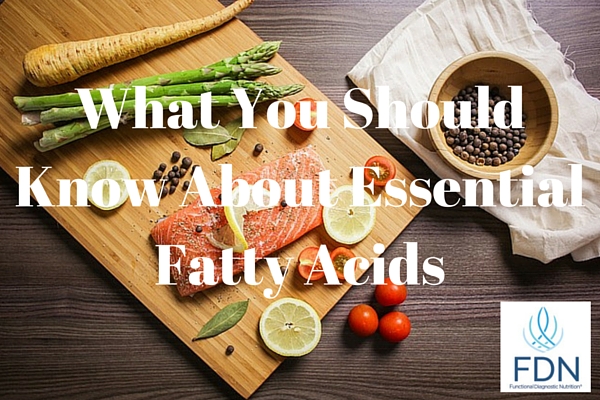Although the importance of essential fatty acids has become a mainstream topic, many people still don’t know exactly what they are or why they’re important. As a result, it’s common for such people to be consuming them in imbalanced or inadequate amounts and be wasting money on supplements that they don’t need.
As with most widespread health information, the food industry takes full advantage of the benefits and popularity of essential fatty acids by using them to market foods that are highly processed and unhealthy. Because of this, many people are consuming these critical fatty acids from less desirable sources and may be compromising their health as a result. To avoid this, it’s important that you know what essential fatty acids are, what they do, and what the best sources are.
What Are Essential Fatty Acids?
Essential fatty acids are fats that we cannot produce ourselves and must therefore obtain from our diets. There are two essential fatty acids which are alpha-linolenic acid (ALA), more commonly known as an omega 3 fatty acid, and linoleic acid (LA) which is an omega 6 fatty acid.
Essential fatty acids are precursors to prostaglandins which are a class of hormones that regulate important physiological functions relating to blood circulation, nerve function, inflammation, hormone regulation, and cell growth. The production of prostaglandins is dependent on the body’s ability to convert the two essential fatty acids into other types of omega 3 and omega 6 fatty acids.
Eicosapentaenoic acid (EPA) and docosahexaenoic acid (DHA) are omega 3 fatty acids that are derived from ALA, and gamma-linolenic acid (GLA) and arachidonic acid (AA) are omega 6 fatty acids that are derived from LA. Because the derivation of these fatty acids can be impaired by a number of factors, it’s beneficial to obtain them from dietary sources as well which is why they’re often referred to as conditionally essential fatty acids.
A Need For Balance
Based on the diets that humans are believed to have consumed for millions of years, and according to Mary Enig who is a respected authority on fats, it’s generally recommended that essential fatty acids represent roughly 2% to 3% of our caloric intake and that 2 to 3 times as much omega 6 fatty acids are consumed as omega 3 fatty acids. Despite this, the typical modern diet is generally deficient in omega 3 fatty acids and excessively high in omega 6 fatty acids. In fact, it’s common for people to eat more than 20 times more omega 6 fatty acids than omega 3, and this type of imbalance is associated with significant health issues including heart disease, stroke, cancer, mood disorders, arthritis, osteoporosis, inflammation, and obesity.
The popularity of industrially farmed foods and processed foods is the primary reason why essential fatty acid imbalances have become so common. Most meat and dairy is produced by conventional farmers who’ve chosen to sacrifice quality in favor of profitability and efficiency by feeding their livestock with unnatural grain based diets. Because grains are high in omega 6 fatty acids and aren’t eaten by these animals in nature, this results in meat and dairy products that are unnaturally high in omega 6 fatty acids and low in omega 3 fatty acids. Likewise, most processed foods are made with grains and vegetable oils which makes them excessively high in omega 6 fatty acids as well.
Because processed food and conventionally farmed meats and produce are so popular, many people are consuming much more omega 6 fatty acids than they should be and not nearly enough omega 3 fatty acids. In contrast, because the importance of omega 3 fatty acids has been emphasized so strongly, some people are overcompensating with excessive omega 3 supplementation and are actually creating an imbalance in the opposite direction.
Deceptive Labeling
With the many people who are now going out of their way to include additional essential fatty acids in their diet, food manufacturers are boasting about omega 3 and omega 6 content on the labeling of their products. Some of these claims are based primarily on omega 6 content which is the opposite of what most people need. More importantly, the simple fact that a product contains omega 3 or omega 6 fatty acids doesn’t mean that it’s a healthy food. In fact, some of these products are highly processed, may even contain dangerous trans fats, and are unhealthy enough to outweigh any of the benefits that may be obtained from the essential fatty acids that they contain.
The Best Sources of Essential Fatty Acids
As with most nutrients, the most natural and sensible approach is to obtain essential fatty acids from natural whole foods which is exactly what we’ve been doing for millions of years.
Walnuts, flax seed oil, chia seeds, and hemp seed oil are common sources of the essential omega 3 fatty acid ALA. Seafood is an excellent source of the conditionally essential fatty acids EPA and DHA which aren’t always properly derived from ALA. Vegetable oils are the most common source of the omega 6 fatty acid LA, and it’s conditionally essential derivative GLA is found in borage oil, black currant oil, evening primrose oil, and hemp seed oil. Meat, dairy, and eggs from pasture raised animals are all good sources of both omega 3 and omega 6 fatty acids. By following a diet that’s based on a healthy balance of these foods and doesn’t include excessive amounts of vegetable oils, essential fatty acid balance should take care of itself and be of little concern.
For the highest quality sources of essential fatty acids, choose meats, eggs, and dairy from pasture raised animals and wild caught fish from minimally contaminated water. If you choose to use supplements, fish oils, or vegetable oils, be sure to get them from a reputable source and store them properly to minimize the risk of oxidation and rancidity. Although supplements and oils are reasonable choices, I prefer to rely mostly on seafood, pasture raised meat, and raw nuts for essential fatty acids.
For more information on essential fatty acids and fats in general, I highly recommend reading Know Your Fats by Mary Enig PhD.








